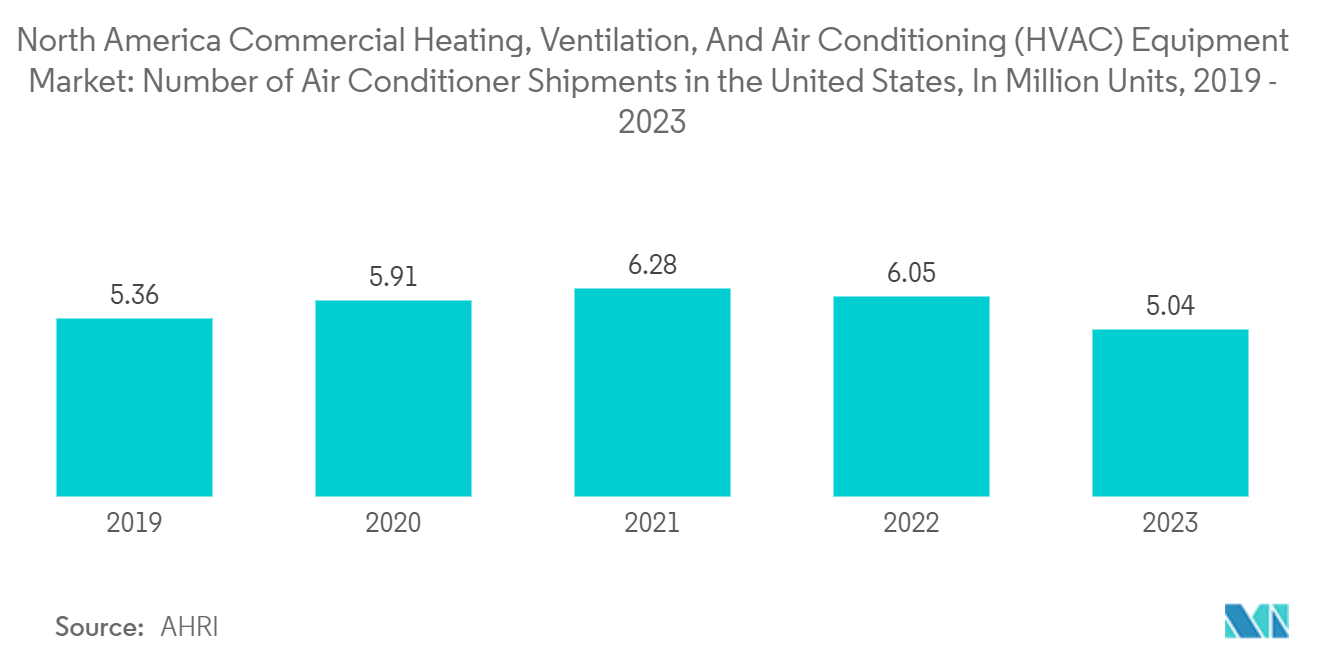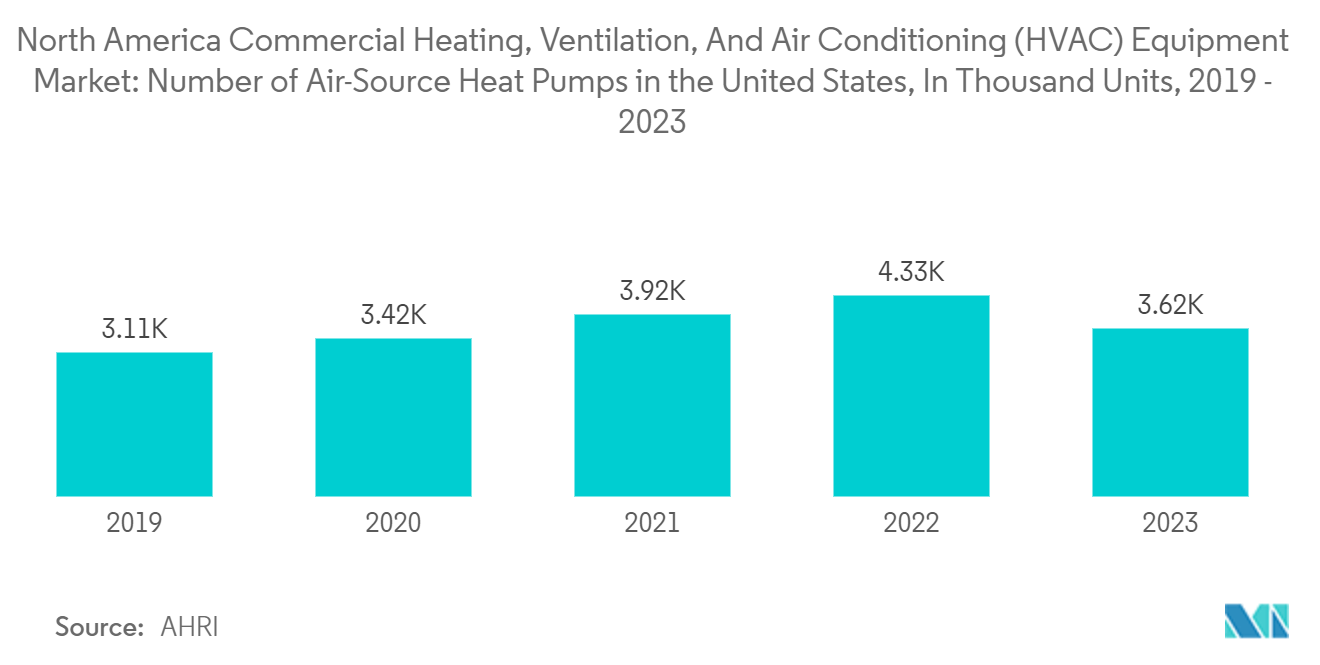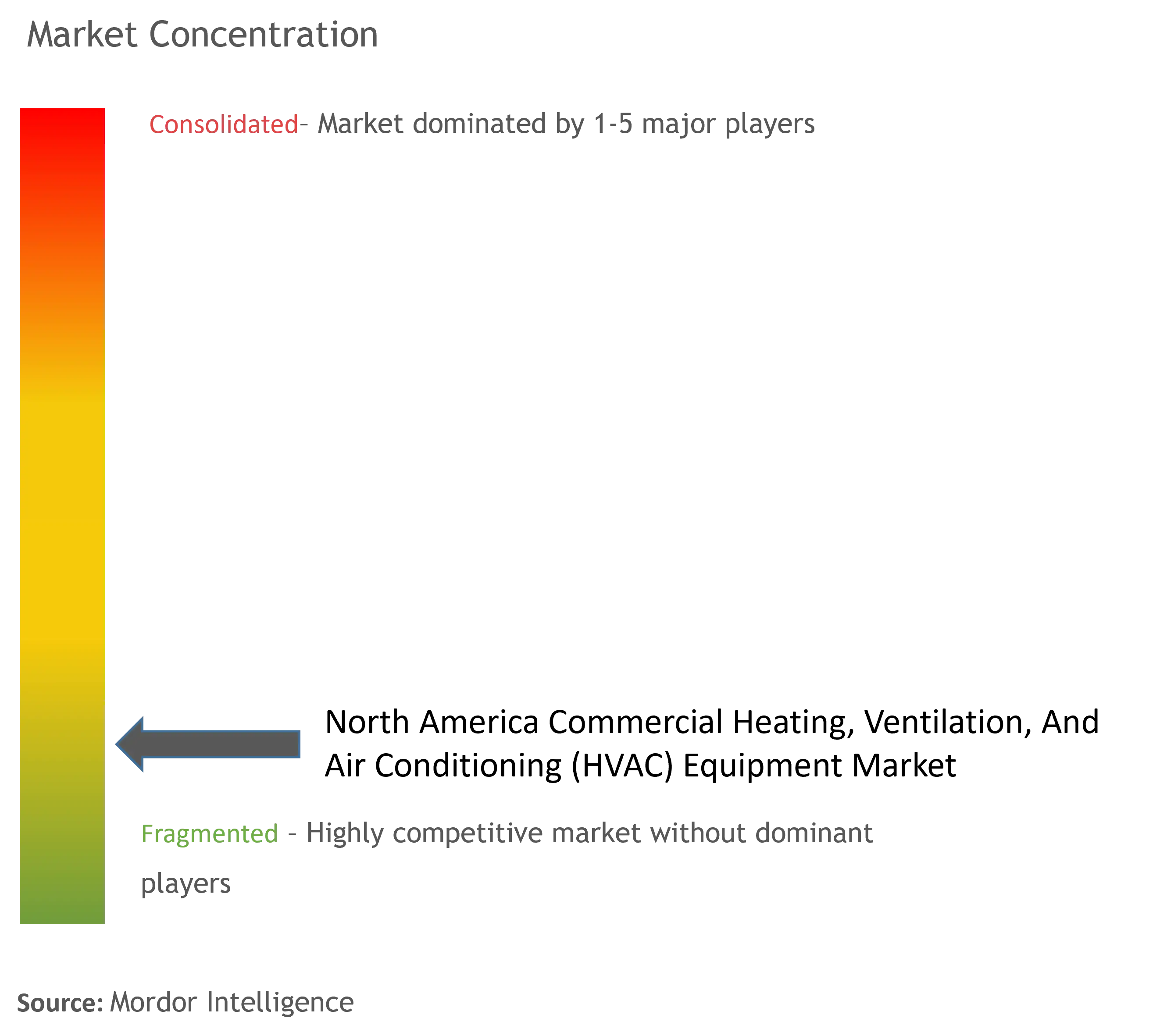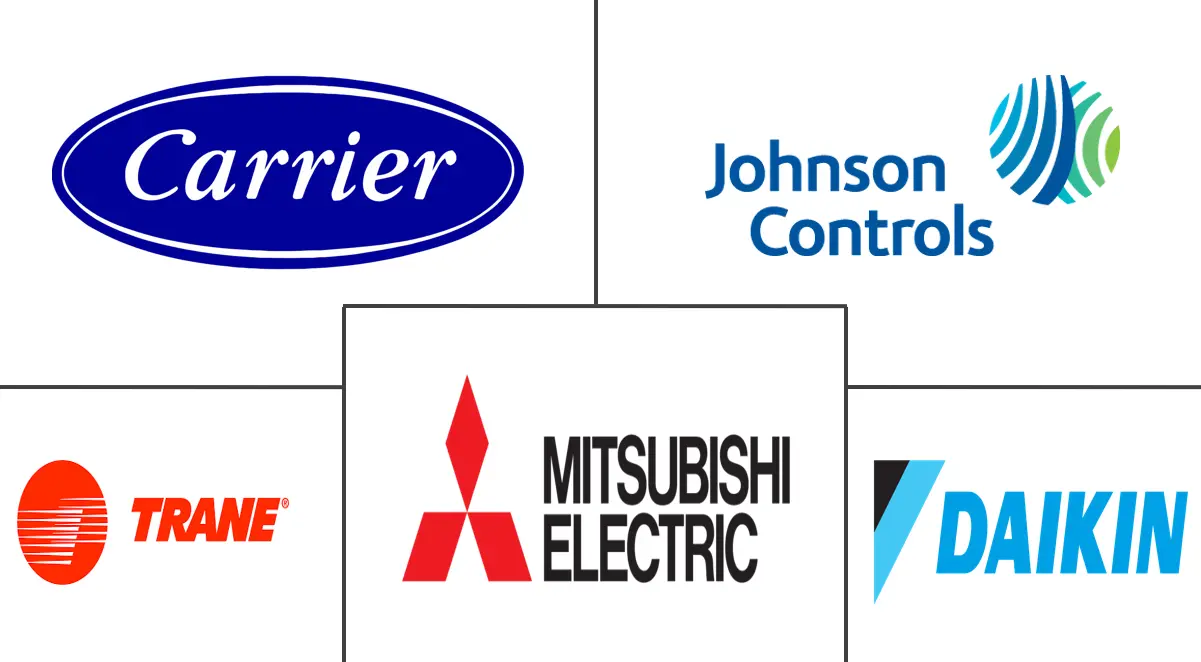North America Commercial Heating, Ventilation, And Air Conditioning (HVAC) Equipment Market Size and Share

North America Commercial Heating, Ventilation, And Air Conditioning (HVAC) Equipment Market Analysis by Mordor Intelligence
The North America Commercial Heating, Ventilation, And Air Conditioning Equipment Market size is estimated at USD 11.41 billion in 2025, and is expected to reach USD 14.64 billion by 2030, at a CAGR of 5.1% during the forecast period (2025-2030).
- The North American HVAC market growth is driven by the increased government support to adopt heat pumps, growing concerns related to global warming, and technological advancement in HVAC equipment. Further, the increased spending on retrofit construction drives the market growth.
- The current global energy crisis implies an urgent need to move to more affordable, reliable, and cleaner ways of heating buildings. Many how commercial buildings around North America, such as retail spaces, office spaces, schools, and universities, still depend on fossil fuels, mainly natural gas, resulting in large amounts of greenhouse gas emissions. Thus, heat pumps are gaining traction as they can efficiently provide heating to commercial spaces and are one the key technologies to make heating more secure and sustainable.
- Governments of the United States and Canada look forward to introducing stringent regulations, thus mandating the incorporation of heat pumps and positively impacting the market. In September 2023, a group of 25 state governors forming the US Climate Alliance and the Biden administration stated that it aims to quadruple the number of heat pumps in the United States homes by 2030 and will reach 20 million from 4.7 million. This is because buildings account for over 30% of global greenhouse gas emissions.
- Due to the colder climatic conditions in North America, there is expected to be an increase in the demand for heating equipment. Climate researchers have theorized that sudden extreme blasts of cold weather in the United States could be fueled by global heating. The Arctic is warming up four times faster than the rest of the planet, leading to changes in the circular pattern of winds known as the polar vortex, which typically concentrates cold air in the polar region.
- Additionally, in 2024, frigid Arctic air from the Northwest Territories is descending into the province of Alberta in Canada, prompting Environment Canada to issue an extreme cold warning. This cold front is also expected to move from the Rockies toward the northern US plains before advancing south, potentially breaking daily cold records in multiple locations.
- The modern HVAC industry is moving towards intelligent technologies due to the integration of AI and Internet of Things (IoT) technology. The modern heat pump differs greatly from the '90s heat pump'. AI-powered heating and cooling technologies can automatically manage indoor, set, and outdoor temperatures. The leading HVAC system providers are incorporating the latest advanced technologies, boosting market growth in the coming years.
- Further, the Russia-Ukrainian war has suspended the global supply chain, directly impacting the sales of HVAC equipment in North America. Also, the US inflation slowed but remained elevated for a year (December 2023-January 2024), according to the US Labor Department data. The annual inflation rate for the United States was 3.1% for the 12 months ending January, compared to the previous rate of 3.4%. The declining inflation rate across the United States and Canada will drive market growth in the coming years.
North America Commercial Heating, Ventilation, And Air Conditioning (HVAC) Equipment Market Trends and Insights
Air Conditioning Equipment is Expected to Witness Remarkable Growth During Forecast Period
- In North America, central air conditioning systems are prevalent in commercial buildings. Another popular option is ductless mini-split systems. They provide zoned cooling, allowing you to control the temperature in different areas of the house independently. Central air conditioners use refrigerants to absorb heat from indoor air and transfer it outside, creating a cooler indoor environment. In North America, high-efficiency central air conditioning units with variable-speed compressors are increasingly favored for their energy-saving benefits and price temperature control.
- According to EIA, commercial buildings will grow by 34% based on square footage. Office buildings use more energy for AC compared to other types of buildings. Commercial buildings will account for 25% of the energy consumed for AC in the United States commercial sector in 2050.
- Ductless mini-split systems are gaining popularity due to their flexibility. Ductless mini splits allow for individualized temperature control in different zones or rooms without ductwork, making them ideal for retrofitting existing buildings or adding cooling capacity to specific areas.
- Also, energy standards and regulations, such as those set by the US Department of Energy (DOE) and Energy Star, drive the adoption of energy-efficient air conditioning equipment in commercial buildings. Building owners and operators prioritize equipment with high seasonal energy efficiency ratios (SEER) and energy-saving features to minimize environmental impact and operating costs.

The United States to Hold Significant Market Share
- The United States is expected to grow with a significant annual growth rate due to government regulations, incentives for heat pump adoption, and significant efforts to avoid CO2 and greenhouse gas emissions. For instance, in November 2023, the Biden administration's recent initiative to enhance the adoption of electric heat pumps and decrease the dependency on fossil fuels involved a substantial investment of USD 169 million by the US Department of Energy. This funding will facilitate the expansion of heat pump manufacturing facilities and the production of crucial components like compressors and refrigerants. Such increasing investments by government agencies are expected to drive the heat pump demand.
- Based on the IEA report, North America has the highest capacity for heat pumps installed for heating buildings. In the United States, heat pump sales surpassed gas furnace sales in 2022, following a period of nearly identical growth. These units tend to be larger compared to those commonly used in Asia, where it is more common to have one unit per room. In the United States, sales of air-to-air heat pumps experienced an approximately 11% growth in 2022, surpassing gas furnace sales after years of similar growth patterns.
- Further, new diseases and increasing cancer cases in the United States create demand for HVAC systems in healthcare facilities to maintain clean air inside the patient, operation, and hospital areas. There were 6,120 hospitals in the United States in 2022, with over 33.7 million hospital admissions.
- Key vendors such as Carrier Corporation and Johnson Controls offer products to keep indoor air clean and pure in hospitals. For example, the OptiClean portable negative air machine developed by the Carrier Corporation helps to keep the air clean and remove air contaminated by the virus.
- Also, AC manufacturers are expanding their product range to fulfill the growing consumer demand for data center applications in the United States. This is in response to the growing number of established data centers, such as Meta's 21 data centers, and the ongoing construction of seven more, including one in Mesa, Arizona. Considering the industry's rapid growth, these manufacturers are focusing on developing solutions to utilize the excess heat generated by these data centers efficiently.

Competitive Landscape
The North American commercial heating, ventilation, and air conditioning (HVAC) equipment market is fragmented and consists of several players. Companies continuously try to increase their market presence by introducing new products, expanding their operations, or entering into strategic mergers and acquisitions, partnerships, and collaborations. Some of the major players include Mitsubishi Electric Hydronics & IT Cooling Systems, Carrier Corporation, Midea Group, Rheem Manufacturing Company Inc., Daikin Industries Ltd, Johnson Controls, Fujitsu Limited, and LG Corporation.
February 2024: Rheem introduced its latest heat pump, the Endeavor Line Classic Plus Series Universal Heat Pump RD17AZ. The Rheem RD17AZ, which is ENERGY STAR certified, has been recognized as the most efficient unit for 2024, even in cold weather conditions. This heat pump is compatible with almost any HVAC system or can be used as a Universal Replacement with minimal modifications.
January 2024: Carrier announced acquiring Viessmann Climate Solutions from the Viessmann Group. This acquisition will strengthen its position in intelligent climate and energy solutions.
December 2023: Daikin launched new expansion valve kits and a control box to connect Daikin DX (Direct eXpansion) outdoor units with air handling units. Operating with refrigerant R-32 and R410a, these kits offer an energy-efficient and low-carbon solution for heating, cooling, and fresh air control to ensure optimal comfort in any commercial space.
North America Commercial Heating, Ventilation, And Air Conditioning (HVAC) Equipment Industry Leaders
-
Daikin Industries, Ltd
-
Mitsubishi Electric Corporation
-
Johnson Controls
-
Carrier Global Corporation
-
Trane Technologies Company, LLC
- *Disclaimer: Major Players sorted in no particular order

Recent Industry Developments
- January 2024: Carrier Global Corporation agreed with Montana Technologies LLC to develop and commercialize Montana's transformational AirJoule dehumidification and cooling technology. In addition, Carrier has conditionally committed USD 10 million in growth equity into Montana to foster commercialization of AirJoule.
- March 2024: Mitsubishi Electric Trane HVAC US LLC (METUS) announced the introduction of Premier Wall-mounted Indoor Units (MSZ-GS/MSY-GS), an update to the former models (MSZ-GS/MSY-GL). Meanwhile, Premier MSZ-GS Indoor Units are compatible with single-zone and multi-zone heat pump outdoor units, including single- and multi-zone Hyper-Heating INVERTER (H2i) units. The Premier MSY-GS is a single-zone, cooling-only air conditioner for climates with unnecessary heating.
North America Commercial Heating, Ventilation, And Air Conditioning (HVAC) Equipment Market Report Scope
Heating, ventilation, and air conditioning (HVAC) control the humidity, temperature, and purity of the air in a surrounding space. HVAC equipment provides thermal comfort and acceptable indoor air quality in both indoor and vehicular environments. It is an integral part of commercial spaces, such as office buildings, shopping malls, and hospitals, where safe and healthy building conditions are regulated concerning temperature and humidity using fresh outdoor air.
The North American commercial heating, ventilation, and air conditioning (HVAC) equipment market is segmented by equipment (air conditioning/ventilation equipment [single splits/multi-splits [ducted and ductless], VRF, air handling units, chillers, indoor packaged/rooftops, and other types] and heating equipment [boilers/radiators/furnaces and other heaters and heat pumps]), end user (public utilities, office spaces, retail spaces, education, healthcare, hospitality, and other end users), and country (United States and Canada). The market sizes and forecasts are provided in terms of value (USD) for all the above segments.
| Air Conditioning/Ventilation Equipment | Single Splits/Multi-Splits (Ducted and Ductless) |
| VRF | |
| Air Handling Units | |
| Chillers | |
| Indoor Packaged/Roof Tops | |
| Other Types | |
| Heating Equipment | Boilers/Radiators/Furnaces and Other Heaters |
| Heat Pumps |
| Public Utilities |
| Office Spaces |
| Retail Spaces |
| Education |
| Healthcare |
| Hospitality |
| Other End Users |
| United States |
| Canada |
| By Equipment | Air Conditioning/Ventilation Equipment | Single Splits/Multi-Splits (Ducted and Ductless) |
| VRF | ||
| Air Handling Units | ||
| Chillers | ||
| Indoor Packaged/Roof Tops | ||
| Other Types | ||
| Heating Equipment | Boilers/Radiators/Furnaces and Other Heaters | |
| Heat Pumps | ||
| By End User | Public Utilities | |
| Office Spaces | ||
| Retail Spaces | ||
| Education | ||
| Healthcare | ||
| Hospitality | ||
| Other End Users | ||
| By Country | United States | |
| Canada | ||
Key Questions Answered in the Report
How big is the North America Commercial Heating, Ventilation, And Air Conditioning Equipment Market?
The North America Commercial Heating, Ventilation, And Air Conditioning Equipment Market size is expected to reach USD 11.41 billion in 2025 and grow at a CAGR of 5.10% to reach USD 14.64 billion by 2030.
What is the current North America Commercial Heating, Ventilation, And Air Conditioning Equipment Market size?
In 2025, the North America Commercial Heating, Ventilation, And Air Conditioning Equipment Market size is expected to reach USD 11.41 billion.
Who are the key players in North America Commercial Heating, Ventilation, And Air Conditioning Equipment Market?
Daikin Industries, Ltd, Mitsubishi Electric Corporation, Johnson Controls, Carrier Global Corporation and Trane Technologies Company, LLC are the major companies operating in the North America Commercial Heating, Ventilation, And Air Conditioning Equipment Market.
What years does this North America Commercial Heating, Ventilation, And Air Conditioning Equipment Market cover, and what was the market size in 2024?
In 2024, the North America Commercial Heating, Ventilation, And Air Conditioning Equipment Market size was estimated at USD 10.83 billion. The report covers the North America Commercial Heating, Ventilation, And Air Conditioning Equipment Market historical market size for years: 2022, 2023 and 2024. The report also forecasts the North America Commercial Heating, Ventilation, And Air Conditioning Equipment Market size for years: 2025, 2026, 2027, 2028, 2029 and 2030.
Page last updated on:
North America Commercial Heating, Ventilation, And Air Conditioning (HVAC) Equipment Market Report
Statistics for the 2025 North America Commercial Heating, Ventilation, And Air Conditioning (HVAC) Equipment market share, size and revenue growth rate, created by Mordor Intelligence™ Industry Reports. North America Commercial Heating, Ventilation, And Air Conditioning (HVAC) Equipment analysis includes a market forecast outlook for 2025 to 2030 and historical overview. Get a sample of this industry analysis as a free report PDF download.



